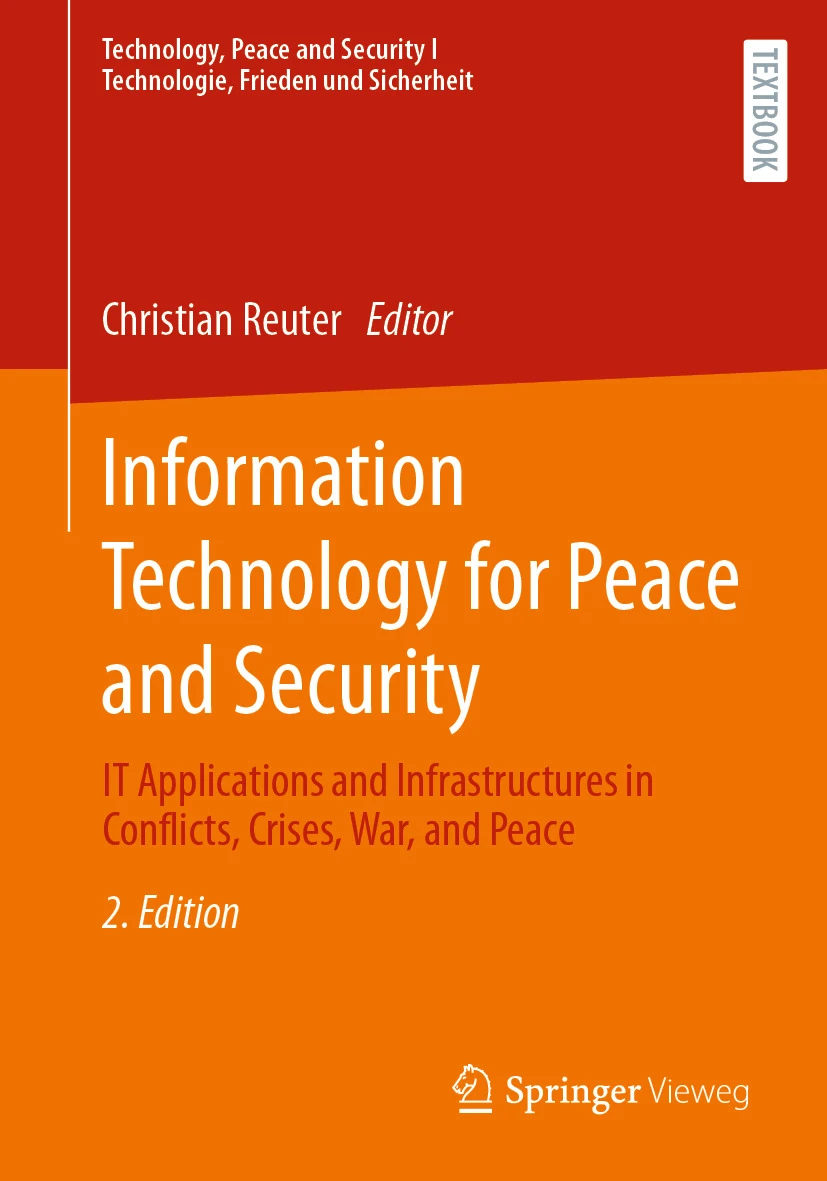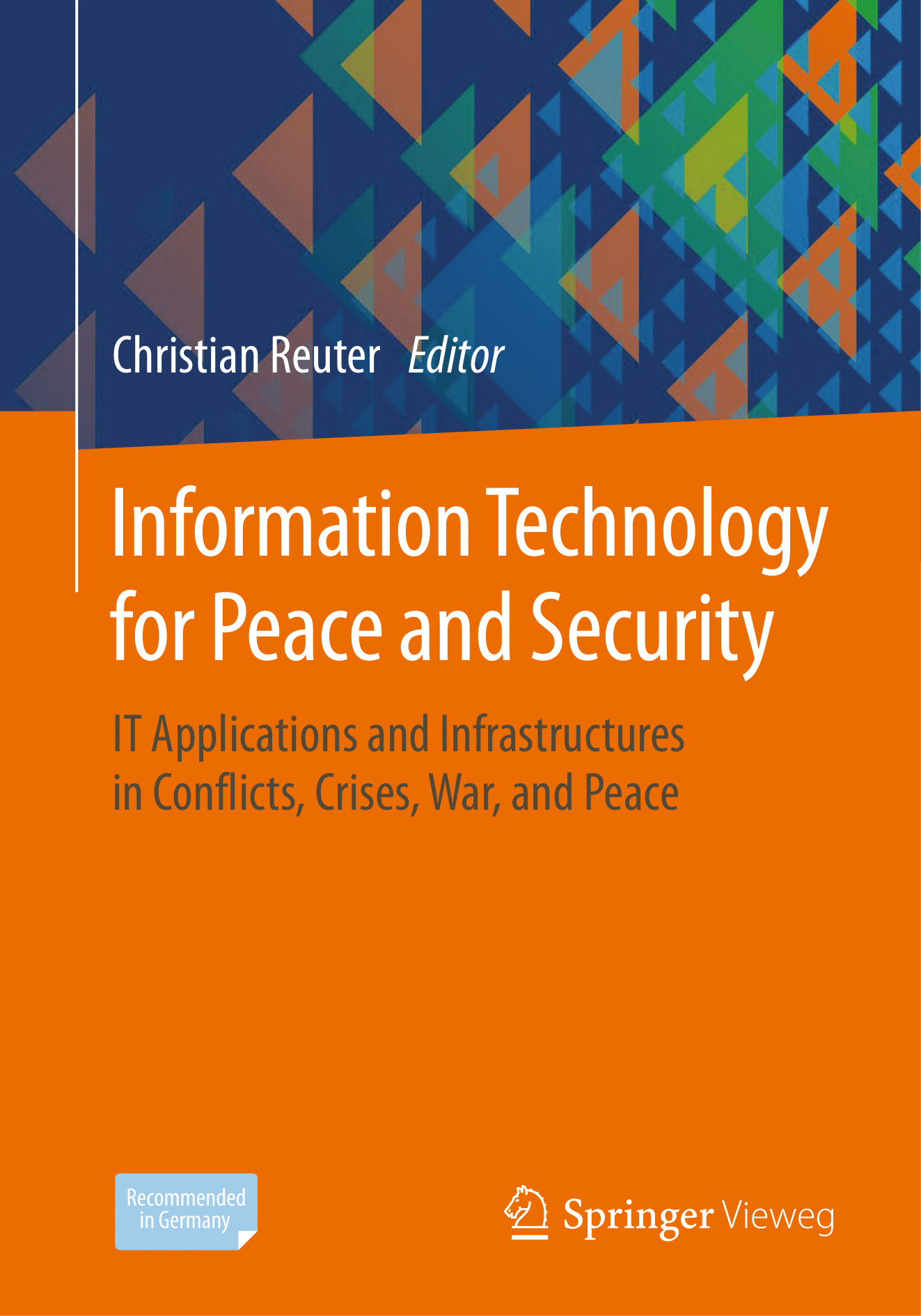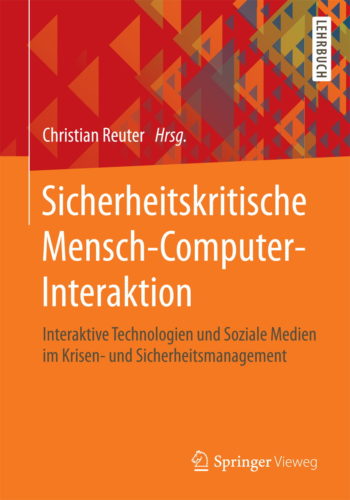Information Technology for Peace and Security
Christian Reuter (2024, Hrsg.) : Information Technology for Peace and Security – IT-Applications and Infrastructures in Conflicts, Crises, War, and Peace. 2nd Ed., Springer Vieweg. DOI:10.1007/978-3-658-44810-3, ISBN 978-3-658-44810-3 (eBook), 978-3-658-44809-7 (Softcover), https://link.springer.com/book/10.1007/978-3-658-44810-3; https://peasec.de/2024/2nd-edition-information-technology-peace-security/
: Information Technology for Peace and Security – IT-Applications and Infrastructures in Conflicts, Crises, War, and Peace. 2nd Ed., Springer Vieweg. DOI:10.1007/978-3-658-44810-3, ISBN 978-3-658-44810-3 (eBook), 978-3-658-44809-7 (Softcover), https://link.springer.com/book/10.1007/978-3-658-44810-3; https://peasec.de/2024/2nd-edition-information-technology-peace-security/
The second edition of Information Technology for Peace and Security – IT Applications and Infrastructures in Conflicts, Crises, War, and Peace has just been released, five years after its initial publication in 2019. This revised and expanded textbook, edited by Prof. Dr. Dr. Christian Reuter and the PEASEC-Team delves into the pivotal role that technological and scientific advancements—particularly in information technology (IT) and artificial intelligence (AI)—play in the realms of peace and security. The book introduces foundational concepts in peace, conflict, and security research, focusing on natural, technical, and computer science perspectives. Subsequent chapters explore critical issues such as cyber conflicts, cyber arms control, cyber attribution, the role of AI, and the importance of ICT infrastructures in managing peace and conflict.
Earlier Edition:
Christian Reuter (2019, Hrsg.) : Information Technology for Peace and Security – IT-Applications and Infrastructures in Conflicts, Crises, War, and Peace. 1st Ed., Springer Vieweg. DOI:10.1007/978-3-658-25652-4, ISBN 978-3-658-25652-4 (eBook), 978-3-658-25651-7 (Softcover),
: Information Technology for Peace and Security – IT-Applications and Infrastructures in Conflicts, Crises, War, and Peace. 1st Ed., Springer Vieweg. DOI:10.1007/978-3-658-25652-4, ISBN 978-3-658-25652-4 (eBook), 978-3-658-25651-7 (Softcover),
https://peasec.de/2019/itps; https://link.springer.com/book/10.1007%2F978-3-658-25652-4; Rezension
Sicherheitskritische Mensch-Computer-Interaktion
Reuter, Christian (2021, Hrsg.):  Sicherheitskritische Mensch-Computer-Interaktion – Interaktive Technologien und Soziale Medien im Krisen- und Sicherheitsmanagement. 2. Aufl., 733, E-Book (ISBN 978-3-658-32795-8, 34,99€), Softcover (ISBN 978-3-658-32794-1; 44,99€), www.peasec.de/lehrbuch; https://www.springer.com/de/book/9783658327941#aboutBook
Sicherheitskritische Mensch-Computer-Interaktion – Interaktive Technologien und Soziale Medien im Krisen- und Sicherheitsmanagement. 2. Aufl., 733, E-Book (ISBN 978-3-658-32795-8, 34,99€), Softcover (ISBN 978-3-658-32794-1; 44,99€), www.peasec.de/lehrbuch; https://www.springer.com/de/book/9783658327941#aboutBook
Die zweite, aktualisierte Auflage dieses Lehr- und Fachbuchs gibt eine fundierte und praxisbezogene Einführung sowie einen Überblick über Grundlagen, Methoden und Anwendungen der Mensch-Computer-Interaktion im Kontext von Sicherheit, Notfällen, Krisen, Katastrophen, Krieg und Frieden. Dies adressierend werden interaktive, mobile, ubiquitäre und kooperative Technologien sowie soziale Medien vorgestellt. Hierbei finden klassische Themen wie benutzbare (IT-)Sicherheit, Industrie 4.0, Katastrophenschutz, Medizin und Automobil, aber auch Augmented Reality, Crowdsourcing, Shitstorm Management, Social Media Analytics und Cyberwar ihren Platz. Methodisch wird das Spektrum von Usable Safety bis Usable Security Engineering von Analyse über Design bis Evaluation abgedeckt. Das Buch eignet sich ebenso als Lehrbuch für Studierende wie als Handbuch für Fachleute aus Wissenschaft, Design, Entwicklung und Anwendung.
Frühere Auflage:
Reuter, Christian (Hrsg.) : Sicherheitskritische Mensch-Computer-Interaktion – Interaktive Technologien und Soziale Medien im Krisen- und Sicherheitsmanagement. 1. Aufl. 2018, 645 S., 147 Abb., E-Book (ISBN 978-3-658-19523-6, 29,99€), Softcover (ISBN 978-3-658-19522-9; 39,99€), www.peasec.de/lehrbuch; http://www.springer.com/de/book/9783658195229
: Sicherheitskritische Mensch-Computer-Interaktion – Interaktive Technologien und Soziale Medien im Krisen- und Sicherheitsmanagement. 1. Aufl. 2018, 645 S., 147 Abb., E-Book (ISBN 978-3-658-19523-6, 29,99€), Softcover (ISBN 978-3-658-19522-9; 39,99€), www.peasec.de/lehrbuch; http://www.springer.com/de/book/9783658195229
Emergent Collaboration Infrastructures
(2014) Emergent Collaboration Infrastructures: Technology Design for Inter-Organizational Crisis Management, S. 280 p. 52 illus., Siegen, Germany: Springer Gabler, url, doi:10.1007/978-3-658-08586-5
Using the domain of crisis management, Christian Reuter explores challenges and opportunities for technology design in emergent environments. He therefore empirically analyzes collaborative work in inter-organizational crisis – such as the police, fire departments, energy network operators and citizens – in order to identify collaboration practices that reveal work infrastructure limitations. He also designs, implements and evaluates novel concepts and ICT artifacts towards the support of emergent collaboration. Besides the discovery of potential organizational effects on the ability to deal with emergence he presents methodological implications for technology design.
A European Perspective on Crisis Informatics
 Christian Reuter (2022): A European Perspective on Crisis Informatics – Citizens’ and Authorities’ Attitudes Towards Social Media for Public Safety and Security. Springer Vieweg. DOI:10.1007/978-3-658-39720-3, (ISBN 978-3-658-39720-3 28,88€ eBook), (978-3-658-39719-7 37,44€ Softcover), https://link.springer.com/book/10.1007/978-3-658-39720-3
Christian Reuter (2022): A European Perspective on Crisis Informatics – Citizens’ and Authorities’ Attitudes Towards Social Media for Public Safety and Security. Springer Vieweg. DOI:10.1007/978-3-658-39720-3, (ISBN 978-3-658-39720-3 28,88€ eBook), (978-3-658-39719-7 37,44€ Softcover), https://link.springer.com/book/10.1007/978-3-658-39720-3
Mobilising helpers in the event of a flood or letting friends know that you are okay in the event of a terrorist attack – more and more people are using social media in emergency, crisis or disaster situations. Storms, floods, attacks or pandemics (esp. COVID-19) show that citizens use social media to inform themselves or to coordinate. This book presents qualitative and quantitative studies on the attitudes of emergency services and citizens in Europe towards social media in emergencies. Across the individual sub-studies, almost 10,000 people are surveyed including representative studies in the Netherlands, Germany, the UK and Italy. The work empirically shows that social media is increasingly important for emergency services, both for prevention and during crises; that private use of social media is a driving force in shaping opinions for organisational use; and that citizens have high expectations towards authorities, especially monitoring social media is expected, and sometimes responses within one hour. Depending on the risk culture, the data show further differences, e.g. whether the state (Germany) or the individual (Netherlands) is seen as primarily responsible for coping with the situation.

 Christian Reuter
Christian Reuter